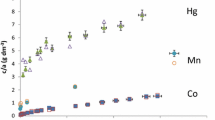Abstract
The extent of protonation of organic bases in clay—water systems depends upon the adsorptive properties of the organo-clay species involved, and upon the structure and degree of hydration of the clay system. Organic molecules that can disperse cationic charge over two or more condensed aromatic rings give rise to greater surface-induced protonation than do single-ring organic molecules with similar solution pKa. Protonation in clay suspensions is frequently far in excess of that predicted on the basis of electrolytic suspension pH and solution pKa of the organic base. For a given organic base, protonation in a clay film exceeds that in the suspended clay system. Protonation in an organo-clay film increases as the film moisture content decreases. The extent of protonation in organo—clay systems varies with cationic species, cationic saturation, and clay type.
Similar content being viewed by others
References
Albert, A. (1968) Heterocyclic Chemistry: Athlone Press, London, pp. 125–133.
Armstrong, D. E. and Chesters, G. (1968) Adsorption catalyzed chemical hydrolysis of atrazine: Environ. Sci. Technol. 2(9), 683–689.
Bailey, G. W., Brown, D. S. and Karickhoff, S. W. (1973) Competitive hydration of quinazoline at the montmorillonite–water interface: Science 182, 819–821.
Bailey, G. W. and Karickhoff, S. W. (1973) An ultraviolet spectroscopic method for monitoring surface acidity of clay minerals under varying water content: Clays & Clay Minerals 21, 471–477.
Bailey, G. W. and White, J. L. (1965) Herbicides: A compilation of their physical, chemical, and biological properties: Residue Reviews 10, 97–122.
Bailey, G. W. and White, J. L. (1970) Factors influencing the adsorption-desorption and movement of pesticides in soil: Residue Reviews 32, 29–92.
Bailey, G. W., White, J. L. and Rothberg, T. (1968) Adsorption of organic herbicides by montmorillonite: Role of pH and chemical character of adsorbate: Soil Sci. Soc. Am. Proc. 32, 222–234.
Benesi, H. A. (1956) Acidity of catalyst surfaces—I: Acid strength from colors of adsorbed indicators: J. Am. Chem. Soc. 78, 5490–5494.
Conley, R. F. and Althoff, A. C. (1971) Surface acidity in kaolinites: J. Coll. Interface Sci. 37(1), 186–195.
Frenkel, M. (1974) Surface acidity of montmorillonites: Clays & Clay Minerals 22, 435–441.
Harter, R. D. and Ahlrichs, J. L. (1967) Determination of clay surface acidity by i.r. spectroscopy: Soil Sci. Soc. Am. Proc. 31, 30–33.
Harter, R. D. and Ahlrichs, J. L. (1969) Effect of acidity on reactions of organic acids and amines with montmorillonite clay surface: Soil Sci. Soc. Am. Proc. 33, 859–863.
Kerr, G. T., Zimmerman, R. H., Tox, H. A. and Wells, F. H. (1955) Degradation of hectorite by hydrogen ion: Clays & Clay Minerals 4, 322–329.
Mortland, M. M. (1970) Clay–organic complexes and interactions: Advan. Agron. 22, 75–117.
Mortland, M. M. and Raman, K. V. (1968) Surface acidity of smectites in relation to hydration, exchangeable cation and structure: Clays & Clay Mineral 16, 393–398.
Paver, H. and Marshall, C. E. (1934) The role of aluminum in the reactions of the clays: J. Soc. Chem. Ind. 53, 750–760.
Perrin, D. D. (1965) Dissociation Constants of Organic Bases in Aqueous Solution 473 pp. Butterworths, London.
Touillaux, R., Salvadore, P., Vandermeersche, C. and Fripiat, J. J. (1968) Study of water layers adsorbed on Na–and Ca–montmorillonite by the pulsed nuclear magnetic resonance technique: Israel J. Chem. 6, 337–348.
Tullock, R. J. (1970) Surface acidity measurements of a bentonite clay with benzoic acid: M.S. Thesis, Dept. of Agronomy, Purdue University, Lafayette, Ind.
Weed, S. B. and Weber, J. B. (1974) Pesticide–organic matter interactions: In Pesticides in Soil and Water (Edited by Guenzi, W. D.) pp. 39–66. Soil Sci. Soc. Am. Inc., Madison, Wisconsin.
Young, J. F. (1967) Humidity control in the laboratory using salt solutions—A review: J. appl. Chem. 17, 241–245.
Author information
Authors and Affiliations
Rights and permissions
About this article
Cite this article
Karickhoff, S.W., Bailey, G.W. Protonation of Organic Bases in Clay—Water Systems. Clays Clay Miner. 24, 170–176 (1976). https://doi.org/10.1346/CCMN.1976.0240404
Received:
Published:
Issue Date:
DOI: https://doi.org/10.1346/CCMN.1976.0240404




